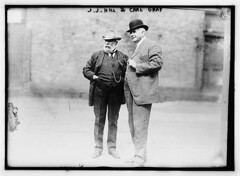The idea that companies are resorting to requesting social media logins and passwords, and in some cases, logins and passwords for email accounts, as reported here seems almost a heartbeat away from some scene from George Orwell's "1984" or "Animal Farm."
But the reality is, setting aside the legal issues and social ramifications, human resources has failed.
With the ability to broadcast job opportunities via Careerbuilder, Monster, and now Indeed (which according to this article is at the top of the list for finding candidates) human resources is finding themselves overwhelmed with candidates for job opportunities and rather than develop better tools to evaluate candidates they find themselves coming up with nothing more than arbitrary means to winnow the potential candidates down to a more manageable level: Relying on such things as not hiring anyone who has been unemployed for any length of time and or requesting logins and passwords to social media sites.
Exactly what benefit is derived from gaining access to an applicant's social media profile? The reality is that anyone seriously looking for employment has already cleaned up their "act" and removed anything that might be questionable and or offensive. As more and more employers rely on the internet to find candidates anyone who is seriously searching for employment will be a step a head of these employers. In fact some employers, those who are on the cutting edge, have moved beyond the resume and are only interested in a candidate's internet presence!
The reality is employers have to learn how to use social media; they have to learn how to "approach" individuals on the web because of their social media presence about potential employment rather than using social media as an excuse not to hire someone. The future belongs to those human resource professionals who learn to be proactive and connect with individuals via social media that they are interested in hiring rather than using the traditional avenues of advertising a job opening, solicit resumes, and then weed through the pile.
But the reality is, setting aside the legal issues and social ramifications, human resources has failed.
With the ability to broadcast job opportunities via Careerbuilder, Monster, and now Indeed (which according to this article is at the top of the list for finding candidates) human resources is finding themselves overwhelmed with candidates for job opportunities and rather than develop better tools to evaluate candidates they find themselves coming up with nothing more than arbitrary means to winnow the potential candidates down to a more manageable level: Relying on such things as not hiring anyone who has been unemployed for any length of time and or requesting logins and passwords to social media sites.
Exactly what benefit is derived from gaining access to an applicant's social media profile? The reality is that anyone seriously looking for employment has already cleaned up their "act" and removed anything that might be questionable and or offensive. As more and more employers rely on the internet to find candidates anyone who is seriously searching for employment will be a step a head of these employers. In fact some employers, those who are on the cutting edge, have moved beyond the resume and are only interested in a candidate's internet presence!
The reality is employers have to learn how to use social media; they have to learn how to "approach" individuals on the web because of their social media presence about potential employment rather than using social media as an excuse not to hire someone. The future belongs to those human resource professionals who learn to be proactive and connect with individuals via social media that they are interested in hiring rather than using the traditional avenues of advertising a job opening, solicit resumes, and then weed through the pile.







